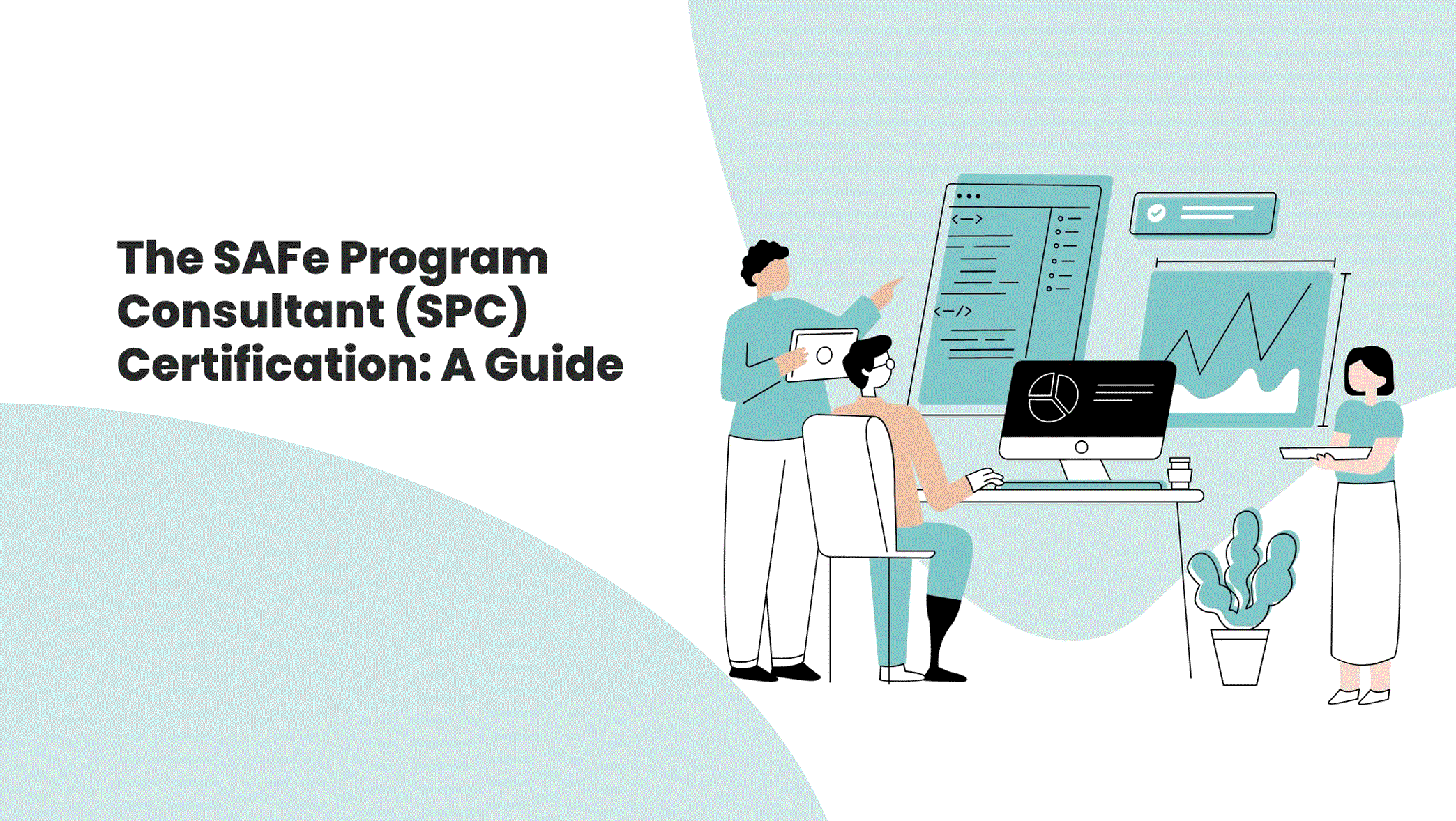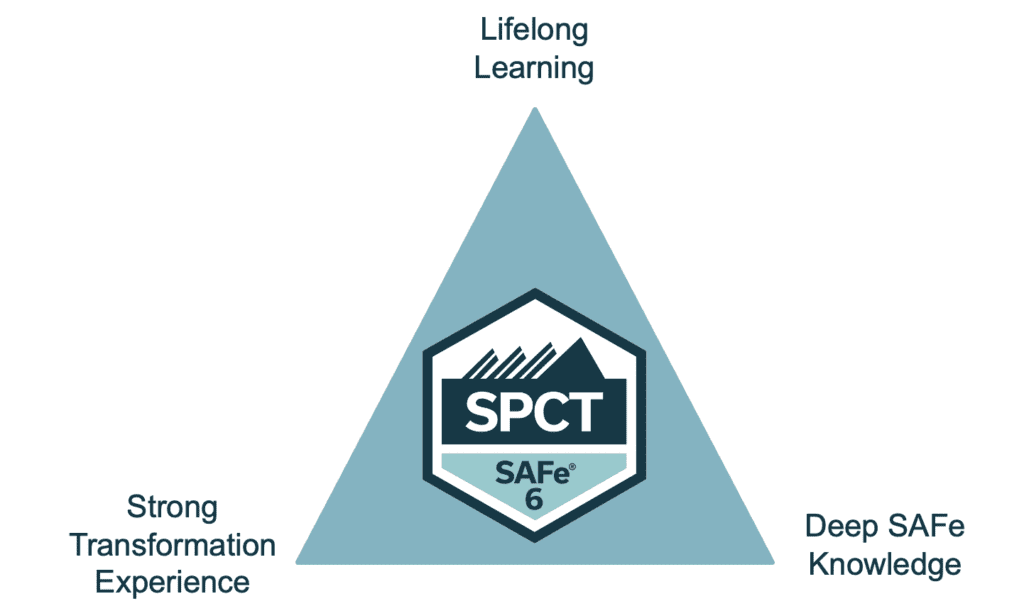- 20-05-2025
- Agile & Scrum
SAFe Practice Consul...
SAFe Practice Consultant (SPC): Roles and ResponsibilitiesIntroduction...
 Get additional 10% off this Christmas!
Get additional 10% off this Christmas!
Enroll by 10th Dec
Promo Code XMAS10

Steps to Becoming an SPC
If you have successfully finished the SAFe® course, you have already made progress toward becoming a Certified SAFe® Practice Consultant (SPC). The demand for Agile coaches and trainers is on the rise, particularly among the leading Global 2000 companies. This increasing need has enhanced the value of SPC certification. However, if you are just starting in this field, understanding the fundamentals of becoming an SPC and other related aspects will provide you with a clearer insight into the profession. This is what we will explore in detail below.
Who is an SPC?
An SPC is a key agent responsible for implementing the entire SAFe framework within an organization. These certified change agents merge their technical expertise in SAFe with a strong intrinsic motivation. This combination enables them to enhance the specific software, systems, and various Agile business processes of the company. SPCs are also vital in ensuring the successful adoption of SAFe.
Additionally, an SPC guides all levels of an organization through a large-scale Lean-Agile transformation. This is typically achieved through comprehensive training, coaching, facilitating, and mentoring.
These professionals come from a variety of internal or external roles, including business and technology leaders, project managers, architects, process leads, analysts, and consultants.
Steps to Becoming an SPC
Obtaining an SPC certification is your initial step toward becoming a professional in this domain. Below is a step-by-step guide to achieving SPC certification:
Enrolling in SPC Certification Training:
Sign up for the SPC certification training conducted by qualified SAFe® Practice Consultant Trainers (SPCTs) at a reputable training institute like Centuera.
Completing the SPC Training:
All professionals are required to complete their training in SAFe® to adequately prepare for the exam and subsequent certification. They can receive training from experienced professionals who have extensive experience in this field.
The training provides learners with the essential knowledge needed to perform and fulfill the responsibilities of an SPC.
Practicing for the Exam:
Practice papers and mock tests are essential before taking the SPC certification exam. You may also request your training institute to provide some mock tests prior to your exam.
Mock papers can inform you about the exam format, types of questions, and what the examiner expects during the exam. This enhances your likelihood of passing the exam on your first attempt.
Attempting the Exam:
The fee for the certification examination for the first attempt is included in the course registration fee, provided the exam is taken within 30 days of completing the course. Each additional attempt or retake beyond the 30-day period incurs a fee of $250.
Becoming a Certified SPC:
You can obtain the SPC certification from Scaled Agile by achieving a score of 75% (45/60) on the exam. This grants you a verified credential to become a certified SPC, enabling you to work across various organizations and industries.
With an SPC certification, you are now equipped to embark on a successful career journey.
Also, check: SPC Certification Process

Skills to Become a SAFe® Practice Consultant (SPC)
To thrive as a SAFe (Scaled Agile Framework) Practice Consultant, it is vital to have a well-rounded skill set. Below are the essential attributes and skills needed for success in this position:
1. Proficient Teaching Skills in Agile Concepts
Expertise in delivering Agile training sessions designed for beginners, ensuring a clear and effective grasp of Agile principles and methodologies.
1. Effective Communication Across Organizational Levels
Strong communication abilities that facilitate smooth interactions with individuals at all levels of the organization, promoting collaboration and understanding across departments.
1. Business-IT Alignment Proficiency
The ability to connect business and IT viewpoints, fostering a unified understanding of organizational goals and ensuring that IT strategies and initiatives are aligned with them.
1. Emotional Intelligence
Having emotional intelligence to effectively manage and navigate interpersonal relationships, empathize with colleagues, and foster a positive and productive workplace.
1. Facilitation Expertise
Proficient facilitation abilities to steer and lead discussions, workshops, and meetings, encouraging collaboration, creativity, and consensus among team members and stakeholders.
1. Agile Process and Workflow Fluency
Comprehensive knowledge and fluency in Agile methodologies and workflows, allowing the consultant to handle complex situations, offer informed advice, and successfully implement Agile practices.
1. Time Management Proficiency
Excellent time management capabilities to effectively organize and prioritize tasks, ensuring that deliverables and milestones are completed on time within the Agile framework.
Who Should Attend the SPC Course?
The Implementing SAFe (SPC) training is crafted to equip individuals with essential insights and skills necessary for guiding organizational transformation towards Agile methodologies. This course is especially advantageous for professionals holding the following roles:
Internal Change Agents
Individuals within the organization who actively promote and advocate for change, motivating others to adopt Agile practices and nurturing a culture of ongoing improvement.
Services Consultants & Coaches
Experts providing services and advice to organizations on Agile implementation, armed with the expertise and resources needed to mentor teams and leaders throughout the transformation journey.
Portfolio Managers & Program Management Office (PMO)
Individuals tasked with managing portfolios and program oversight, acquiring knowledge on how Agile principles can be effectively utilized at both portfolio and program levels to boost overall organizational performance.
IT Managers, Program Managers, and Leaders
Key figures in the IT sector, program managers, and those responsible for guiding teams and initiatives towards Agile practices, ensuring alignment with the organization's goals and objectives.
Enterprise, System, and Solution Architects
Professionals engaged in architectural roles at various levels, learning to incorporate Agile methodologies into architectural processes and strategies within the larger enterprise framework.
Anyone Leading Processes
Individuals who are at the forefront of various organizational processes and aim to deepen their knowledge of Lean-Agile principles while aiding in the effective execution of Agile programs.
Those Responsible for Agile Program Implementation
Professionals assigned the duty of executing Agile programs as part of a broader Lean-Agile transformation initiative within the organization.
What are the Advantages of Becoming an SPC?
Although the SPC certification and training may seem daunting, the benefits are substantial. Here are the advantages of pursuing SPC certification training that will alleviate your concerns:
What Steps to Take After Becoming an SPC?
Becoming an SPC elevates professionals to a significant level. This is due to the fact that it allows you to
What are the Duties of an SPC?
SPCs facilitate discussions about change across various business departments and organizational levels. They must communicate with expertise and confidence to be effective in team dialogues. Here are the key responsibilities of an SPC that you should be aware of:
What Courses can SPCs Teach and Where?
As an Independent SAFe Practice Consultant (SPC), you are permitted to teach various public in-person courses. However, you must not be affiliated with a Partner Organization. There is a limitation in that you cannot promote these public trainings on the SAI's training calendar. This is because all advertised public courses are designated for the Gold, Silver, and Platinum Partners of Scaled Agile.
Therefore, if you are not part of these partners, you are not authorized to publish on SAI's training calendar. You are also allowed to conduct private courses remotely as an independent SPC, and you can train individuals in person.
Conclusion
SPCs need to undergo training for their new role. These professionals must also obtain certification to be qualified to train others. They must acquire the necessary tools and skills to fulfill their responsibilities. This is how SPCs learn to coach and instruct others in implementing change. So, how can this be achieved? The most effective method is to implement SAFe through the SPC certification classes. This specific four-day course equips aspiring SPCs to become change agents for effective transformation.
FAQs
Why should I opt for SPC Certification Training?
Obtaining the Implementing SPC Certification Training demonstrates your expertise in applying the SAFe Framework, lean principles, and Product development flow concepts within an organization. SAFe® Certification contributes to career advancement and offers a competitive salary.
How much is the cost of Implementing SPC Certification Training?
The initial attempt at the SPC exam is included in the course registration fee, provided the exam is taken within 30 days of completing the course. Each subsequent retake of the exam incurs a fee of $250.
Is it necessary to renew my SPC certifications?
Yes, the SAFe certification must be renewed on an annual basis.
What is the procedure for renewing the Implementing SPC Certification?
The Implementing SAFe® Certification Training is valid for one year and includes membership in the SAFe® Community Platform. Individuals have the option to renew their certification within the first year.
What is the structure, duration, and format of the SAFe® Practice Consultant exam?
The SAFe® Certification exam is conducted online and consists of various questions. Candidates are allotted 120 minutes (2 hours) to complete the exam once it starts.
How can I download my SPC Certification after passing the exam?
You can download and print the SPC Certification Certificate from the Manage Profile -> Professional Development -> Certifications/Programs section.

SAFe Practice Consultant (SPC): Roles and ResponsibilitiesIntroduction...
Steps to Becoming an SPCIf you have successfully finished the SAFe® co...
Agile vs Scrum: Essential Distinctions, Advantages, and Selection Guid...